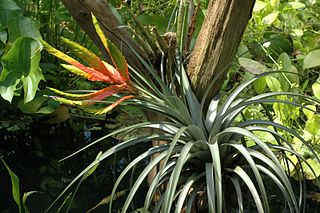
Symplocos is a genus of flowering plants in the order Ericales. It contains about 300 species distributed in Asia and the Americas. Many species grow in humid tropical regions. This is sometimes considered to be the only genus in family Symplocaceae. Plants in this family are shrubs and trees with white or yellow flowers.

Tillandsioideae is a subfamily of plants in the bromeliad family Bromeliaceae. This subfamily contains the greatest number of species (1,277). Most are epiphytic or lithophytic, growing in trees or on rocks where they absorb water and nutrients from the air. Spanish moss of the Tillandsia genus is a well-known variety. Bromeliads in the genera Guzmania and Vriesea are the more commonly cultivated members of this subfamily.

Nidularium is a genus in the plant family Bromeliaceae, subfamily Bromelioideae. Named to describe the nestling characteristic of the inflorescence, all the species are endemic to Brazil. Commonly confused with Neoregelia which they resemble, this plant group was first described in 1854.
Ultra low expansion glass (ULE) is a registered trademark of Corning Incorporated. ULE has a very low coefficient of thermal expansion and contains as components silica and less than 10% titanium dioxide. Such high resistance to thermal expansion makes it very resistant to high temperature thermal shock. ULE has been made by Corning since the 1960s, but is still very important to current applications.
Symplocos subandina is a species of plant in the family Symplocaceae. It is endemic to Ecuador. Its natural habitat is subtropical or tropical moist montane forest.

Petunia axillaris, the large white petunia, wild white petunia or white moon petunia, is an annual herbaceous plant in the family Solanaceae, genus Petunia. It is native to temperate South America. The plant's flowers, the only white ones found in the Petunia genus, are 3 to 7 cm long. The commonly-grown garden petunia is a hybrid of P. axillaris and P. integrifolia.
Mezobromelia bicolor is a plant species in the family Bromeliaceae. This species is native to Ecuador and Colombia.
Josemania truncata is a species of flowering plant in the family Bromeliaceae, native to Colombia and Ecuador. It was first described by Lyman Bradford Smith in 1954 as Tillandsia truncata. Plants of the World Online sinks the genus Josemania into Cipuropsis, treating this species as Cipuropsis truncata.
Cipuropsis amicorum is a species of flowering plant in the family Bromeliaceae, native to Venezuela. It was first described in 1990 as Tillandsia amicorum.
Josemania asplundii, synonym Tillandsia asplundii, is a species in the genus Josemania, native to Ecuador and Peru. It was first acquired by the 1842 United States Expedition in South America.
Josemania singularis, synonym Cipuropsis singularis, is a species of flowering plant in the family Bromeliaceae. This species is native to Costa Rica and Panama.
Ernst Heinrich Georg Ule was a German botanist.
Cipuropsis is a genus of flowering plant in the family Bromeliaceae, native to the Caribbean, southern Central America and northwestern South America. The genus was first described by Ule in 1907.
Cereus trigonodendron, synonym Cereus braunii, is a species of flowering plant in the family Cactaceae, native to Bolivia, North Brazil and Peru. It was first described in 1908 by Ernst Heinrich Georg Ule who attributed the name to Karl Moritz Schumann. Ule described Cereus trigonodendron as a striking triangular columnar cactus, up to 15 m tall, with large purple flowers at the top.
Josemania is a genus of flowering plant in the family Bromeliaceae, first described in 2016.
Josemania delicatula, synonym Cipuropsis delicatula, is a species in the family Bromeliaceae, native to Colombia.
Josemania pinnata, synonym Cipuropsis pinnata, is a species in the family Bromeliaceae, native to Panama, Colombia and Ecuador.
Mezobromelia hospitalis, synonym Cipuropsis hospitalis, is a species of flowering plant in the family Bromeliaceae, native to Colombia. It was first described by Lyman Bradford Smith in 1948 as Tillandsia hospitalis.
Mezobromelia magdalenae, synonym Cipuropsis magdalenae, is a species of flowering plant in the family Bromeliaceae, native to Colombia. It was first described by Lyman Bradford Smith in 1963 as Vriesea magdalenae.
Cipuropsis asmussii is a species of flowering plant in the family Bromeliaceae, native to Venezuela. It was first described by Eric J. Gouda in 2017.



